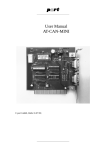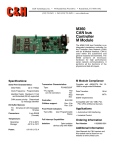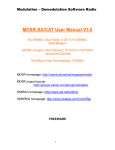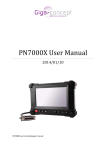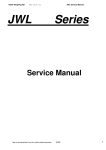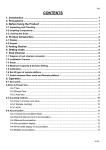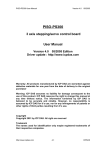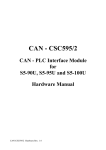Download AT -CAN-MINI User Manual
Transcript
AT-CAN-MINI User Manual © port GmbH, Halle 31.07.1999; Disclaimer All rights reserved The programs, boards and documentations supplied by port GmbH are created with due diligence, checked carefully and tested on several applications. Nevertheless, port GmbH can not take over no guarantee and no assume del credere liability that the program, the hardware board and the documentation are error-free respective are suitable to serve the special purpose. In particular performance characteristics and technical data given in this document may not be constituted to be guaranteed product features in any legal sense. For consequential damages, which are emerged on the strength of use the program and the hardware boards therefore, every legal responsibility or liability is excluded. port has the right to modify the products described or their documentation at any time without prior warning, as long as these changes are made for reasons of reliability or technical improvement. All rights of this documentation lie with port. The transfer of rights to third parties or duplication of this document in any form, whole or in part, is subject to written approval by port. Copies of this document may however be made exclusively for the use of the user and his engineers. The user is thereby responsible that third parties do not obtain access to these copies. The soft- and hardware designations used are mostly registered and are subject to copyright. We are thankful for hints of possible errors and may ask around for an information. We will go all the way to verify such hints fastest Copyright 2002 port GmbH Regensburger Straße 7c D-06132 Halle Tel. +49 345 - 777 55 0 Fax. +49 345 - 777 55 20 E-Mail [email protected] Internet http://www.port.de Page 2 of 13 AT-CAN-MINI User Manual Version: 1.2 Status: Rel Table of Contents 1. Technical Data . . . . . . . . . . . . . . . . . . . . . 4 2. Hardware . . . . . . . . . . . . . . . . . . . . . . . 6 2.1. Addressing . . . . . . . . . . . . . . . . . . . . . . 6 2.2. CAN-Controller . . . . . . . . . . . . . . . . . . . . 7 2.3. Address-/data multiplexor . . . . . . . . . . . . . . . . . 7 2.4. Connection to the Bus . . . . . . . . . . . . . . . . . . 8 2.5. Optical isolation . . . . . . . . . . . . . . . . . . . . 8 2.6. CAN driver . . . . . . . . . . . . . . . . . . . . . . 8 2.7. Interrupt . . . . . . . . . . . . . . . . . . . . . . . 9 . . . . . . . . . . . . . . . . . . . . . . . 10 3.1. Introduction . . . . . . . . . . . . . . . . . . . . . . 10 3.1.1. Data types and structures . . . . . . . . . . . . . . . . . 10 3.2. Content of disk . . . . . . . . . . . . . . . . . . . . . 11 4. Appendix . . . . . . . . . . . . . . . . . . . . . 12 4.1. Example canrec.c . . . . . . . . . . . . . . . . . . . . 12 4.2. Example cansend.c . . . . . . . . . . . . . . . . . . . 13 3. Software . . AT-CAN-MINI User Manual Version: 1.2 Status: Rel Page 3 of 13 1. Technical Data AT-CAN-MINI provides a CAN network interface for PC-AT compatible computers. It is designed as a short PC slot card with dimensions 100mm x 150mm. PC interface is a ISA direct connector. The CAN network connection is made by an SUB-D-9male and SUB-D-9female connector physically it is designed according to ISO/DIS 11898 and the recommendations of CiA (CAN in Automation e. V.). After plug in the card into the PC slot the CAN connectors are available at the PC’s backboard. The CAN interface is optically isolated against the PC voltage level. AT-CAN-MINI occupies 32 addresses in the PC’s I/O address space. The starting address is selectable by jumpers. The CAN controller can generate interrupts at the PC bus. The interrupt number is also selectable by jumpers. As CAN controller the BASIC CAN SJA1000 by Philips is used. Port GmbH provides C-library functions for simple functions to program the controller. The library is foreseen and tested with the following compilers: BORLAND C++ 2.0 and BORLAND TURBO C 2.01 PC-Interface ISA-direct board connector CAN-Interface 2 x SUB-D-9 according ISO/DIS 11898 and CiA recommendation CAN-Controller SJA1000 CAN-driver SJA1000 or SI9200 address area 32 byte between 200h - 3E0h Interrupts IRQ3 - IRQ7 selected by jumper Dimension 100mm x 150mm Table 1, technical data overview Page 4 of 13 AT-CAN-MINI User Manual Version: 1.2 Status: Rel BR1 W1 BR2 U4 Y1 BR4 JP2 120 Ohm BR3 ADR INT 80H 40H 2 4 6 100H 20H 200 H+ 1 3 5 7 JP1 3 4 5 6 7 JP3 8 BR5 Figure 1, jumpers and soldering bridges AT-CAN-MINI User Manual Version: 1.2 Status: Rel Page 5 of 13 2. Hardware Following is an overview schematic of the board. CANbus Opto Barrier and Driver Basic CAN Controller Address Decode Data Driver Interrupt Logic AT ISA-8 Bus Figure 2, AT-CAN-MINI schematic 2.1. Addressing AT-CAN-MINI uses an 32 byte address window in the I/O address space of the PC. In this area the controllers register are mapped. Begin address of this I/O area is located between 200h and 3E0h. With jumper JP3 it can be freely assigned in steps of 32 byte, 20h. Page 6 of 13 AT-CAN-MINI User Manual Version: 1.2 Status: Rel 1-2 3-4 5-6 7-8 Adresse I I I I I I I I I I I I I I I 200h 220h 240h 260h 280h 2A0h 2C0h 2E0h 300h 320h 340h 360h 380h 3A0h 3C0h 3E0h I I I I I I I I I I I I I I I I I Table 2, I/O address jumpering with JP3 Legend: I ... jumper applied 2.2. CAN-Controller As CAN controller the Philips Basic CAN SJA1000 clocked with 16 MHz is used. The clock is generated at board. Together with the CAN driver circuit SJA1000 bit rates up to 1 MBaud are possible. The controller is used in the Intel-Mode. Signals are driven from a PAL (22V10). By using a CAN controller which handles all layer 2 protocol the user only has to provide data in the transmit buffer. The controller then transmits the message automatically. Also receiving is done automatically. Received messages must only be read from the registers. 2.3. Address-/data multiplexor The used CAN controller SJA1000 has an shared data/address bus. To use the 32 registers of the SJA1000 address lines A0...A4 of the PC are used. These lines must be multiplexed with data lines D0..D7. Address/data multiplexor is built by the circuit U6 (unidirection address) and U5 (bidirectional data). Control signals "DEN*" and "AEN*" as also the correct timing are created by the PAL U8. AT-CAN-MINI User Manual Version: 1.2 Status: Rel Page 7 of 13 2.4. Connection to the Bus The physical connection to the CAN bus is realized by two parallel connected SUB-D-9 connectors according to DIN 41652. Pin Signal Description 1 2 3 4 5 6 7 8 9 CAN_L GND (GND) CAN_H (V+) reserved CAN_L (dominant low) ground reserved reserved ground (optional) CAN_H (dominant high) reserved (error line) external power supply 7V - 13V (optional) Table 3, pin assignment for the SUB-D-9 CAN The two connectors make it possible to grind the bus through the AT-CAN-MINI. 2.5. Optical isolation Optical isolation is provided by the coupler U2 for transmitting and U1 for receiving. Galvanical isolation between the 5 V Power Supply and the CAN driver circuit with optocoupler U2 is done with the DC/DC converter W1. If this is not necessary following changes has to be made: components: U1, U2 and W1 do not mount; soldering bridges: BR1, BR2, BR3 and BR4 close; If the board is already assigned with U1, U2 and W1, then the soldering bridges BR2, BR3 and BR4 are not accessible in order to protect the components. If a galvanic connection is desired and the components already mounted, the soldering bridge BR1 must be closed. The slot plate with mounted DSUB connectors is normally connected with ground of the PC by bridge BR5. Within industrial PC’s with no connection between housing and processor ground the bridge must be disrupted. 2.6. CAN driver As a CAN driver the PCA82C250T or SI9200 can electively be used. Both are pin compatible. Driver and opto coupler build a CAN interface according to ISO/DIS 11898. If the SI9200 is used, the resistor R2, reducing the steepness of signal edges with PCA82C250T, is not necessary. Steepness is proportional to the used resistor. Page 8 of 13 AT-CAN-MINI User Manual Version: 1.2 Status: Rel Following relations are valid: value R2 result 0 (PIN 8 at GND) open 10kOhm .. 100kOhm highest steepness standby modus slope control Table 4, influence of steepness Formula: calculation of edge steepness t slope = − 3 * 10− 5 + 36 [V / µ s] Standard resistor with 10 KOhm yields in a steepness of 30V/µs. 2.7. Interrupt To achieve the capability to generate interrupts from the CAN channel one of the interrupt lines must selected with the "INT" jumper JP1. It can be selected from the lines IRQ3 to IRQ7. IRQ5 is preferred. 1-2 3-4 5-6 7-8 9-10 IRQ I IRQ3 IRQ4 IRQ5 IRQ6 IRQ7 I I I I Table 5, interrupt jumpering with JP1 I..jumper applied Attention ! Only one jumper must be applied. AT-CAN-MINI User Manual Version: 1.2 Status: Rel Page 9 of 13 3. Software 3.1. Introduction The CAN controller with the AT-CAN-MINI is driven in I/O mode, That means that communicating with the board is done by 32 addresses in the PC’s I/O address range. Port GmbH provides with the C-library can_util.lib some functions to easy access the CAN controller. Following functions are delivered: Function Short description CAN_PortInit() CAN_PortMask() CAN_PortStatus() CAN_PortTxRdy() CAN_PortRxRdy() CAN_PortTx() CAN_PortRx() CAN_PortIRQ_E() CAN_PortIRQ_D() CAN_PortIRQRead() initialization of the CAN controller programming acceptance and mask registers read controller status check transmit readiness check receive readiness send message read message enable interrupts disable interrupts read interrupt register Module number To be able to use the library also with boards with more then one CAN controller, a module number is provided with all calls to functions. Because AT-CAN-MINI has only one controller Module number is always 1. Following conventions are used: • • TRUE = 1 FALSE = 0 The provided examples only should show how to use the library functions. Therefore no sanity checks are within it. 3.1.1. Data types and structures Some of the functions get or deliver data types BYTE. It is declared as typedef unsigned char BYTE; and allocates one byte in memory. Page 10 of 13 AT-CAN-MINI User Manual Version: 1.2 Status: Rel telegramm is a structure, containing all necessary informations for a CAN message: message is the CAN identifier from or to other CAN nodes 11 Bit in a bit field rtr identifier for an Remote Transmit Request (RTR) 1 Bit in a bit field count number of bytes to send or received 4 Bit in a bit field daten With CAN up to 8 bytes can be transfered. The message data are stored in an 8 byte array of unsigned char. 3.2. Content of disk With the provided disk are the following files: File Description can_util.h can_util.lib canrec.c cansend.c readme Header file for CAN functions library file example 1 example 2 notes for using examples Table 6, content of supplied disk AT-CAN-MINI User Manual Version: 1.2 Status: Rel Page 11 of 13 4. Appendix 4.1. Example canrec.c The example waits for an incoming CAN message and displays the contents of the message. It runs until the user hits one key. More notes to the example are in the file readme. #include #include #include #include #define #define #define #define <stdio.h> <dos.h> <bios.h> "can_util.h" OFF ON MOD1 MOD2 0 1 1 2 BYTE bus0 = 0x89; BYTE bus1 = 0xEB; BYTE mask = 0xFF; BYTE acc = 0xFF; int port_adr = 0x280; int modul = MOD1; main() { can_telegramm rx; int z; int i; int schalter = OFF; /* Modul Nr. 1 */ /* Modul Nr. 2 */ /* /* /* /* /* /* Bustiming Register 0 */ Bustiming Register 1 */ Maskenregister */ Akzeptanzregister */ Adresse I/O-Port */ Modulnummer */ /* Empfangsstruktur */ /* Durchlaufzähler */ /* Zählvariable */ /*--- CAN-Controller initialisieren ----------------------------------*/ CAN_PortInit (port_adr, MOD1, bus0, bus1); CAN_PortMask (port_adr, MOD1, mask, acc); /*--- periodisch empfangen ----------------------------------------*/ while (schalter == OFF){ while (!CAN_PortRx(port_adr, modul, &rx) && schalter == OFF){ delay(1); z++; if (z > 5000){ printf("warte0); z = 0; } if (bioskey(1)) schalter = ON; } if (schalter == OFF){ printf("Message: %d0,rx.message); printf("Count: %d0,rx.count); for (i = 0; i < rx.count; i++){ printf("Daten hex: %x0,rx.daten[i]); printf("Daten char: %c0,rx.daten[i]); printf("Daten dezimal: %d0,rx.daten[i]); } } } } Page 12 of 13 AT-CAN-MINI User Manual Version: 1.2 Status: Rel 4.2. Example cansend.c The programm periodically sends a message. Message data are entered over the command line. It runs until the user hits one key. More notes to the example are in the file readme. #include #include #include #include #include #include #define #define #define #define BYTE BYTE BYTE BYTE <stdio.h> <dos.h> <bios.h> <stdlib.h> <string.h> "can_util.h" OFF ON MOD1 MOD2 0 1 1 2 /* Modul Nr. 1 */ /* Modul Nr. 2 */ bus0 = 0x89; bus1 = 0xEB; mask = 0xFF; acc = 0xFF; /* /* /* /* int port_adr = 0x280; int modul = MOD1; Bustiming Register 0 */ Bustiming Register 1 */ Maskregister */ Acceptanzregister */ /* Adresse I/O-Port */ /* Modulnummer */ main (int argc, char *argv[]) { can_telegramm tx; int z; int schalter = OFF; /*--- Sendestruktur beschreiben -------------------------------------*/ tx.message = atoi(argv[1]); tx.count = atoi(argv[2]); strcpy(tx.daten, argv[3]); /*--- CAN-Controller initialisieren -----------------------------------*/ CAN_PortInit(port_adr, modul, bus0, bus1); CAN_PortMask(port_adr, modul, mask, acc); /*--- periodisch senden ------------------------------------------------*/ while (schalter == OFF){ while (!CAN_PortTx(port_adr, modul, &tx) && (schalter == OFF)){ delay(1); z++; if ( z > 5000){ printf("warte0); z = 0; } if (bioskey(1)) schalter = ON; } } } AT-CAN-MINI User Manual Version: 1.2 Status: Rel Page 13 of 13













